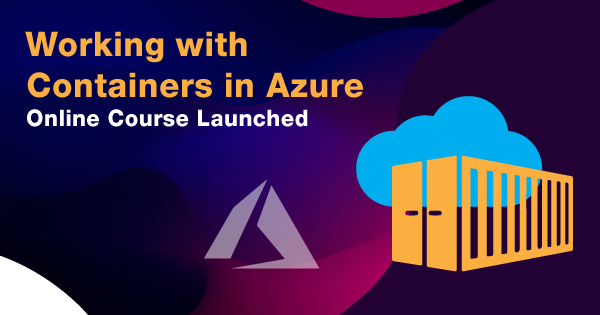Working with Containers in Azure
Since the world of tech is moving at such a breakneck pace these days, you must be able to run your critical software, tools, and programs from anywhere and quickly. You can’t waste days configuring and checking various environments, operating systems, and dependencies.
Optimizing application delivery has increased in recent years, thanks to the rise of Cloud Computing and DevOps activities. Whizlabs is making sure that it covers up every course which will make you stand out whether you are applying for a job or you are looking for growth in your current job. After the last course on Automating Infrastructure – Chef for DevOps was launched, we ought to cover Containers. Containers are one such technology that has grown in popularity and is now generally recognized as the form of the future.
A survey conducted, found that the majority of employed and about to be employed crowd looks up to Azure to solve their tech problems. A larger majority of students think that Azure is a sure way to impress their analytics and get a good promotion. These are some of the reasons Whizlabs is launching the course ‘Working with Containers in Azure’.
What are containers?
Containers are a common unit of software that bundles up code and all its inputs so that the programme runs easily and reliably from one computing environment to another.
Why choose Azure containers?
- They are simple: There’s no need to build up a virtual system for each program with containers. On a common virtual machine, multiple containers will run, each fully isolated from the others.
- They cost less: A container, as previously mentioned, separates each application without needing a wholly distinct environment. This eliminates the need to licence – and pay for – a separate operating system for each container. Similarly, an expensive hypervisor isn’t needed to handle each of those virtual machine instances.
- It can be replicated effortlessly: It is simple to replicate the same data centers to a new infrastructure using containers, regardless of how different that framework is.
What will you get from this course?
- The course will teach you to create environments which are lighter. Your application will not overheat nor overhead. It instantly eliminates the chances of application crashing by a 100%.
- You will be able to run your applications on almost all the platforms.
- Faster deployment, patch and scale options.
- Learn to migrate your applications into a more modern environment.
Course Handbook
One thing that we emphasize during the teaching sessions too is the fact that the way software works is the same way we humans function in daily life. Like how every kitchen has different compartments for different vessels, a software too has different areas which have their own application. This whole division of applications at different areas of the software is also known as containerization and a package software is known as a container. The course will introduce you to the base concept and also see to it that you get perfect understanding of the workings.
When you see a poorly developed application, the first thing to blame is the running environment of the software. The poor environment in which the code runs attributes to its failure. There are differences in configurations, libraries are not set up properly and the dependencies are not taken care of. This creates a very messy environment. What the course will teach you through the use of containers is, how to avoid this exact messy environment and make sure that the application you present to an industry will function smoothly. Whizlabs will make sure that by the end of the course you will be able to provide a light infrastructure for the application which is most demanded in the highest companies right from Reliance to Volkswagen.
The online course of Working with Containers in Azure aims to help beginners understand what are containers in Microsoft Azure and how to deploy them. Check it out today!
A part of the course will teach you and make you capable of providing standardized format for packaging for an application. The application you will create will be so versatile in nature that it won’t just work on ‘one machine’ but on every type of machine whether it be OS or Windows.
The course includes inclusive teachings of users to practice Azure CLI which helps in managing Azure instances. This follows by the introduction of functions like Azure cloud shell and Azure portal.
Once this is done, Whizlabs finds it highly important for you to have an experience in creating your first basic container. It may seem like a leap step, but it’s not. In fact, it’s very essential in order to understand and have fun when you move to the next step. During the creation you will be taught to check the status of the new container, listing multiple containers and overriding the defaults.
Find out the 40+ Best Performing Free Tests from Whizlabs!
A very essential part in Azure containers lies within container orchestrators. There are many out of which Kubernetes and Docker Swarm are one of the most reputed ones. They have better leverage. Orchestra as the title suggests is a group of containers. There will be discussion and tutorial lectures on projects related to this.
- Top 20 Questions To Prepare For Certified Kubernetes Administrator Exam - August 16, 2024
- 10 AWS Services to Master for the AWS Developer Associate Exam - August 14, 2024
- Exam Tips for AWS Machine Learning Specialty Certification - August 7, 2024
- Best 15+ AWS Developer Associate hands-on labs in 2024 - July 24, 2024
- Containers vs Virtual Machines: Differences You Should Know - June 24, 2024
- Databricks Launched World’s Most Capable Large Language Model (LLM) - April 26, 2024
- What are the storage options available in Microsoft Azure? - March 14, 2024
- User’s Guide to Getting Started with Google Kubernetes Engine - March 1, 2024

